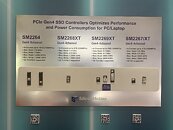Q2 NAND Flash Contract Prices Expected to Rise by 13-18%, Enterprise SSDs to See Highest Increase
TrendForce projects a strong 13-18% increase in Q2 NAND Flash contract prices, with enterprise SSDs expected to rise highest. Despite Kioxia and WDC boosting their production capacity utilization rates from Q1 this year, other suppliers have kept their production strategies conservative. The slight dip in Q2 NAND Flash purchasing—compared to Q1—does not detract from the overall market's momentum, which continues to be influenced by decreasing supplier inventories and the impact of production cuts.
eMMC demand is predominantly driven by Chinese smartphone brands, leading to a substantial boost in shipments from Chinese module makers as some suppliers have reduced their supply. Buyers are increasingly adopting solutions from module makers to meet production needs, enhancing the technological advancement of Chinese module factories and their outreach to premier clients. This trend is likely to increase the penetration of eMMC products among smartphone customers, with a projected 10-15% rise in eMMC contract prices in Q2 due to a sharp rebound in NAND Flash wafer prices.
eMMC demand is predominantly driven by Chinese smartphone brands, leading to a substantial boost in shipments from Chinese module makers as some suppliers have reduced their supply. Buyers are increasingly adopting solutions from module makers to meet production needs, enhancing the technological advancement of Chinese module factories and their outreach to premier clients. This trend is likely to increase the penetration of eMMC products among smartphone customers, with a projected 10-15% rise in eMMC contract prices in Q2 due to a sharp rebound in NAND Flash wafer prices.







































